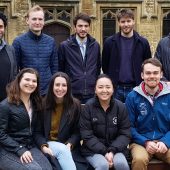
Dr Taha Yasseri
Former Senior Research Fellow
Taha Yasseri analyses large-scale transactional data to understand human dynamics, collective behaviour, collective intelligence and machine intelligence.
1st of April marks the anniversary of the start of our project!
In this post we give a short recap of our activities in HUMANE during its first year.
The Beginning!
What Are We Doing?
Literature Review
Typology
Case Studies
Dimensions and Concepts
…More
In the emerging hyper-connected era, people and appliances are online all the time. In HUMANE we focus on how work, private life, civic engagement, knowledge, creativity, and innovation are increasingly conducted in networks comprising of humans and machines. We’ve termed such networks “human-machine networks”, where network reflects a higher abstraction level than the technical system or machine.
The HUMANE kick-off meeting last year in Oslo.
The challenge is that human-machine networks cannot be developed and implemented in the same manner as networks of machine nodes alone. Creating successful solutions for human-machine networks requires awareness concerning the kind of network to be established (e.g. simple networking and information-sharing or complex collaboration), the social characteristics (e.g. non-existent, latent, weak, or strong ties), and a conceptual framework to assess the fit of the ICT solutions.
The overall objective of HUMANE is to improve public and private services by uncovering how new configurations of human-machine networks change patterns of interaction, behaviour, trust and sociability, and how public and private services need to fit the specific networks involved.
To this end, HUMANE seeks to develop a HUMANE typology and method, tailored to a human-centred design process and applicable to ICT developers and designers, and a HUMANE roadmap tailored to the need to support future thinking, regulatory activities, and policy-making. During the first 12 months of the project, the first version of the HUMANE typology and method has been developed. We will start developing the HUMANE roadmap in the second year of the project.
Journals publishing articles related to human-machine networks.
In order to develop a theoretically grounded typology, we needed to first review the literature. It wasn’t an easy task to scope and review the massive body of knowledge generated on human-machine networks over the past few centuries under various names and titles. Read how we did so and about our review paper here.
Our main task during the first year was to provide a typological framework, within which we can profile existing and/or hypothetical networks. The ideal typology should be simple, yet comprehensive enough to be able to capture and distinguish different cases in a meaningful way. It also has to provide the needed base for the second part of the project, the road map. The developed typology has to talk to the design patterns and the socio-temporal dynamics of networks. Yet it has to be abstract enough and easy to comprehend! We are happy to announce that we completed our first version of the HUMANE Typology just in time. Read about it and the corresponding paper here.
Joint profile for the peer-to-peer reselling network of Snapsale.
Do you know that HUMANE is not solely a theoretical project? We have 6 case studies, through which we inspire, develop, and validate our typology. A by-product of this process is the new knowledge that we generate on each of these cases. For example, read about our work on the “dynamics of disagreement in Wikipedia” here.
Through developing the HUMANE Typology, we discuss various aspects and dimensions of human-machine networks. While some of these aspects are easier to grasp, like “geographical extension of the network”, others are more sophisticated and need further investigation. This has resulted in additional analytical publications. Read the one on “Machine Agency; Impact and Trust” here.
You know where to find our papers as well as a link to our Mendeley group!
And if you’re reading this you probably know our website, but you might also want to check our Twitter account, and you might even want to follow us!